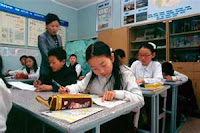Mongolia education of school system was that Education in Mongolia traditionally was controlled by the Buddhist monasteries and was limited to monks, Tibetan was the language of instruction, the canonical and liturgical language, and often many years were required to complete formal degrees, which included training in logic and debate. With the exception of medicine, which involved and extensive pharmacopoeia and training in herbal medicines, higher was esoteric and unworldly. Major monasteries supported four schools: philosophy, doctrine and protocols; Medicine; Mathematics, astrology and divination; and Demonology and demon suppression. At the beginning of the 20th century, officials and wealthy families hired tutors for their children and Government offices operated informal training that taught the intricacies of written records, standard forms and accounting. The official source of Mongolia, which tended to depict the prerevolutionary period as one of total backwardness, probably underestimated the level of media literacy, but it is definitely low.
Secular education began soon after the collapse of the Chinese authorities in 1911. Mongolian language school was opened in the Russia shade Huree in 1912; many of the teachings of the forty-seven students were done by Buryat Mongols of Siberia. In the same year opened the military school instructor with Russia.1914 a school to teach Russia operating in Mongolia's capital. The candidate who, in a pattern that became public, go to cities in Russia for further training. In response to the challenge, as some secular schools, monasteries in the 1920s, probably running a school for boys, that should not be monastic vows. Schools such as used in Mongolia and learning plans to have content that is very religious.
Education is slowly evolving throughout the 1920s. Late in 1934, when 55 percent of all party members are illiterate, secular State schools enrolled only 2.7 per cent of all children aged 8-17, while 13% in this age group in the monastic schools. Suppression of monasteries in 1938 to 1945 monastic schools, and closed schools State that continues to grow throughout the 1940s and 1950s. In 1941, the traditional Mongol script, based on the Uighur script was replaced by Cyrillic. It took from 1941 to 1946--sources differ on the date--to apply this change really. Mongolia Government announced that universal adult literacy has been achieved by 1968. Russia's printing, opened in Yihe Huree in the early 20th century, changed, Russia and Mongolia translation novel tracts politics; in 1915 the first newspaper printed in Mongolia,
Higher education in Mongolia joined the Communist revolution in the early 20th century and is based on the Soviet model. Since its founding, the higher education system has seen significant growth for today. 2003, there were 178 colleges and universities, although only 48 of them publicly. However, there are 98,031 students in public universities in relation to private students, 31,197 shows the importance of continuing to publicly funded higher education in Mongolia. Under Communist rule all of higher education is given free of charge. Since the early 1990s, however, fees were introduced, although the Government still provides grants and scholarships. the quality of education in the institutions that owned personally considered to be generally low.
There are a lot of universities in Mongolia. The most notable is the National University of Mongolia in Ulaanbaatar, established in 1942 (as Choybalsan University) with three departments: education, medicine and medicine. The Faculty is Russia, which is the language of instruction. In 1983, is a Technical University Institute and the language teacher training Institut Russia a separate company, known as Polytechnic Institute and the Institute of languages of Russia, respectively. Polytechnic Institute, with 5,000 students, concentrating on engineering and mining. Mongolia State University, taught by approximately 4,000 students, pure science and mathematics, social sciences, economics and Philology. More than 90 percent of the Faculty of Mongolia; teachers also came from the Soviet Union, Eastern Europe, France and the United Kingdom. Many clues are in Russia, reflecting the lack of the Mongol language text in Advanced and specialized field.
In addition to Mongolia State University there are seven institutions of higher learning: the Institute of Medicine, Institute for agriculture, Institute of Economics, State Institute of Pedological, Polytechnic Institute, the Institute of languages of Russia and the Institute of physical Culture. In the summer have all students each semester work, where they helped with the harvest, formed "shock work" teams for construction projects or work in the Soviet Union or another Comecon country. At the beginning of 1989 Education Authority announced in the third and fourth year engineering students going to companies that they will be given the following exams, so their training could be focused with practical ends in mind.
Research and scholarship
Scholars suffer from
useful links
http://www.num.edu.mn/Default.aspx?alias=www.num.edu.mn/eng
http://www.accmon.mn/english/5.htm
http://www.msue.edu.mn/en/news.php
http://www.num.edu.mn/Default.aspx?alias=www.num.edu.mn/eng
http://www.accmon.mn/english/5.htm
http://www.msue.edu.mn/en/news.php




